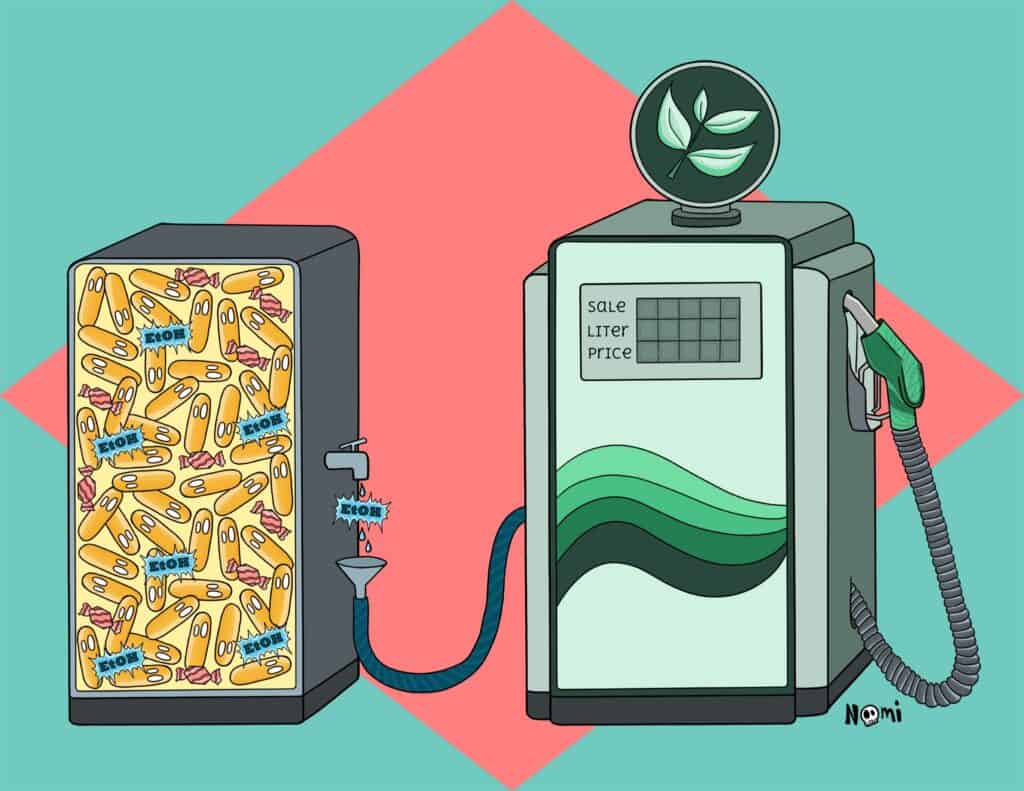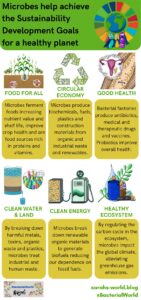One of the biggest reasons for our climate change dilemma is the burning of non-renewable fossil fuels. So, to decrease greenhouse gases in the atmosphere, we need to switch to green biofuels as energy sources. One sustainable alternative to petroleum fuel is bioethanol, which is also a lot healthier for the environment.
Many organisms learned to produce bioethanol: plants, fungi and yes, also bacteria. And they can use many different substrates to do so: plants and wood or food waste. You probably know the alcoholic smell of over-ripe fruits or juices.
So, why not use this bacterial superpower to help us with our energy crisis? Let’s look at another possibility of how bacteria could save the health of our planet by producing alternative energy sources.
Where does bioethanol come from?
Microbes can produce ethanol in a process called microbial fermentation. This means that they break down sugars to produce ethanol and energy for the cell.
This process also takes place when producing wine and beer or rising bread dough.
But to produce biofuels, it gets a bit messier because the substrates often come from food or plant waste. And often, uncharacterised microbial communities cover them.
In these cases, the microbial communities work together to make use of all the components of the waste.
For example, the walls of plant cells contain very rigid and long sugar molecules – so-called polymers. Certain bacteria can break down these long polymers into single sugar molecules.
Then, other organisms – often yeast strains – produce ethanol from the sugar molecules in the fermentation process. And when producing beer or wine or rising bread, it is usually our good old friend the baker’s yeast that produces the ethanol for us.
But when it comes to producing bioethanol, we need a lot of it and we need it fast. How lucky are we that one bacterium produces bioethanol a lot more efficiently than yeast strains?
Meet Zymomonas mobilis – the fastest bacterial bioethanol producer.
Why does Zymomonas mobilis not get drunk?
From every single sugar molecule, Zymomonas mobilis produces two ethanol molecules. As you can imagine, Zymomonas mobilis produces a lot of ethanol during its lifetime. So much, it would get you and me super drunk and would damage our bodies irreversibly. But ethanol is not just toxic for us – it also is for bacteria.
Ethanol is a so-called chaotropic compound. This means it disturbs the organisation of biological macromolecules. Hence, proteins and DNA can get disrupted and lose their function. Like this, the bacterial outer envelope gets completely disorganised and bacterial cells lose their stability.
Because of that, most bacteria cannot stand the tiniest bit of ethanol as they get drunk and become intoxicated.
But not Zymomonas mobilis.
This bacterium can live on ethanol without losing it. It knows very well how to protect itself from the toxic effects of ethanol.
Zymomonas mobilis carries a special sugar in its outer envelope. Because of these sugar molecules, a water layer surrounds the membrane. And this water layer blocks the ethanol from coming into contact with the membrane. Hence, the sugar-water shield protects the membrane and the bacterium.
Also, Zymomonas mobilis produces a biofilm that blocks ethanol from entering the bacterial community. And researchers also found that when Zymomonas mobilis lives in biofilms, it produces even more ethanol.
This sounds like something to create communities of Zymomonas mobilis biofilms that efficiently produce ethanol on an industrial scale.
Zymomonas mobilis as an efficient biofuel-producer
Researchers are already on it to use this superhero bacterium to tackle our energy crisis. They are looking into feeding Zymomonas mobilis different substrates from food leftovers or plant waste.
Unfortunately, our superhero bacterium cannot break down the long sugar polymers from plant cells. This means that for industrial processes, the food or plant waste needs to be pre-treated to break down the polymers. But this step also increases costs and processing time.

An alternative is to use other bacteria or microbes that can break down the polymers into single sugar molecules.
Zymomonas mobilis then uses its very efficient sugar transporters to import the sugar molecules into the bacterium. Now, the bacterium can ferment the sugars and produce bioethanol.
Can you see how this is yet another example of how microbes feed each other?
So far, this process is not optimised for huge-scale industrial applications. But it seems clear that it might be bacteria that help us with yet another crisis.











